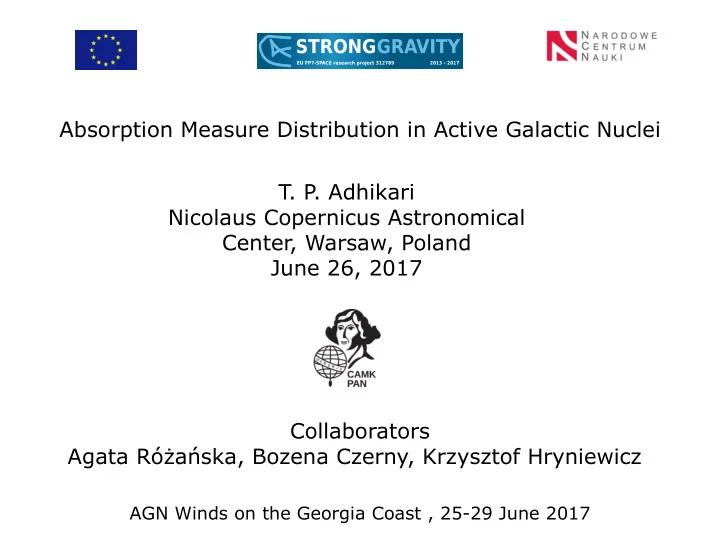

Absorption Measure Distribution in Active Galactic Nuclei T. P. Adhikari Nicolaus Copernicus Astronomical Center, Warsaw, Poland June 26, 2017 Collaborators Agata Ró ż a ń ska, Bozena Czerny, Krzysztof Hryniewicz AGN Winds on the Georgia Coast , 25-29 June 2017
Outline • Absorption Measure Distribution (AMD) in AGNs: definition and observational motivation • Photoionisation modelling of AMD • Results from our modelling using TITAN (Dumont+ 2000) photoionisation code • Summary
Absorption measure distribution (AMD) in AGNs : from observations Holczer+ 2007 • AMD requires ξ and N H ξ =L/nR 2 Holczer+ 2007 • N ion is derived by fitting Gaussian profiles to the X-ray absorption lines in the observed spectra • ξ and f i on are computed from photoionisation models
Equivalent H- column densities Importance of different ions, Fe in particular Holczer+ 2007
Absorption measure distribution (AMD): Observation Behar 2009 Discontinuity in Observational evidence of Thermal the observed AMD instability (TI)? Holczer + 2007, Behar 2009
Absorption measure distribution (AMD): Observation Mrk 509 (Detmers + 2011) two AMD dips !
Absorption measure distribution (AMD): Modelling • Broad band SED • Gas density n SED • Column Density N H • Metallicity Z • Ionisation parameter, ξ =L/nR 2 n,Z, N H • Solving the radiative transfer, ionisation equilibrium and thermal balance • Main Codes: CLOUDY (Ferland +2013), TITAN (Dumont+ 2000), absorption lines XSTAR (Kallman & Bautista 2001),..
AMD: models Radiation Pressure Confinement (RPC) model (Stern+ 2014) using CLOUDY ξ (erg cm s-1 ) RPC model in CLOUDY did not reproduce TI
AMD in Mrk 509: constant total pressure (P gas +P rad ) single model TITAN code reproduces TI problem with the normalisation! Adhikari + 2015, ApJ
Density dependence of AMD Adhikari + 2015, ApJ for Mrk 509 SED, the position of AMD dip depends on density
RPC in Cloudy versus constant pressure in TITAN TITAN (Constant total pressure ) CLOUDY (RPC) • Escape probability method • more accurate Accelerated of radiative transfer Lambda Iteration (ALI) method • radiation pressure is computed • pressure induced by the from radiation field and goes trapped emitted radiation into the gas structure directly is not considered Escape probability method versus ALI method (Dumont+ 2003)
Systematic study of AMD using TITAN low-spin-high-mdotr high-spin-low-mdotr Adhikari+ 2017, in preparation
Systematic study of AMD using TITAN Adhikari+2017, in preparation
Systematic study of AMD using TITAN: normalisation and position of dip in AMD N H ≥ 10 23 cm -2 N H ~10 21 -10 22 cm -2 SED - with strong X-ray illumination SED- with strong opt/UV component Adhikari+ 2017, in preparation normalisation is higher for SED with strong X-ray illumination
In case of SED with strong optical/UV component and for high density, free free heating dominates over the Compton heating
data: Behar 2009 TITAN model: SED with with strong optical/ UV component, log N H =22.48 , log n H =12
Summary • Constant total pressure single component WA model explains the observed AMD in Mrk 509. • Computations of AMDs with the constant pressure assumption for different SED components shows that the normalisation is higher for SED with strong X-ray illumination and weak optical/UV component. • For the given SED, the position of AMD dip depends on the density of the absorber.
Back up slides…
Recommend
More recommend